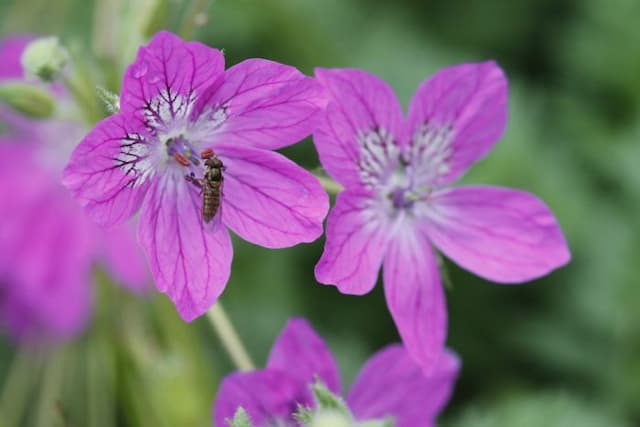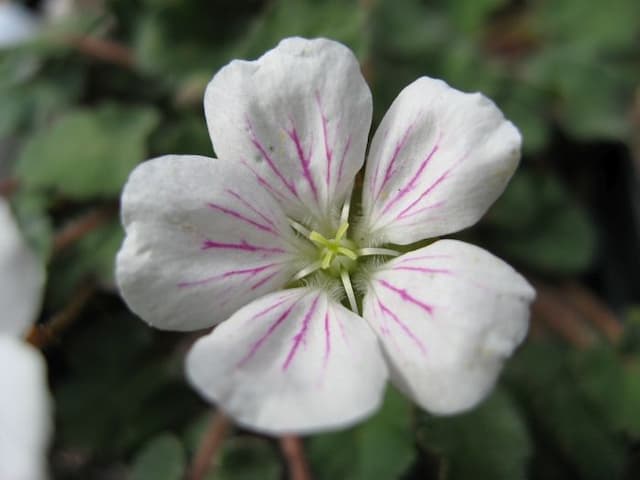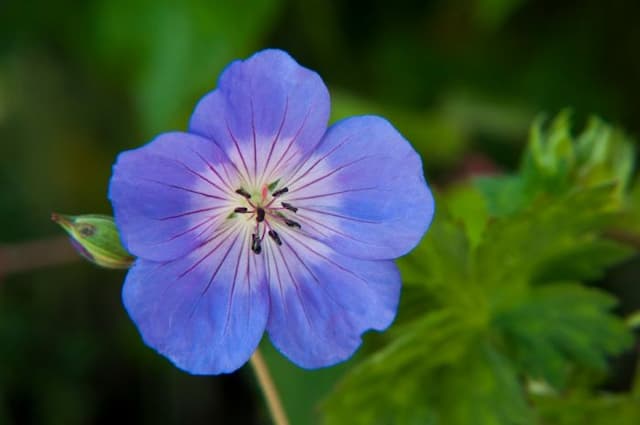Cranesbill Geranium 'Anne Thomson'

ABOUT
Geranium 'Anne Thomson' is characterized by its lush green foliage, which forms a mound of deeply lobed leaves that provide a dense backdrop to its vibrant flowers. The leaves may have a slightly serrated edge, adding texture to the plant's appearance. Bursting forth from this foliage are the striking flowers, which are notable for their vivid magenta color with prominent dark veins running through the petals. The blooms feature five rounded petals that spread outwards, often with a slight overlap at the edges, creating a cupped effect that is quite eye-catching. These distinctive flowers are held aloft on slender stalks, that rise well above the foliage, creating a lively and colorful display that can add a burst of brightness to any garden space. The bold contrast of the dark veins against the lighter magenta petals is one of the key ornamental features of this plant, making it a favorite among gardeners for its showy presence.
About this plant
 Names
NamesSynonyms
Cranesbill, Hardy Geranium.
Common names
Geranium 'Anne Thomson'.
 Toxicity
ToxicityTo humans
The geranium plant is not considered highly toxic to humans. However, if ingested in large amounts, some people might experience mild symptoms such as upset stomach, nausea, vomiting, or diarrhea. It's important to keep in mind that individuals with sensitive skin may also have a reaction to handling geraniums, such as dermatitis. As with all plants, it's wise to avoid ingesting parts of the geranium plant and to wash hands after handling it, especially before touching the face or eating.
To pets
Geraniums are considered to be toxic to pets, including dogs and cats. If your pet ingests part of a geranium, they might exhibit symptoms of toxicity, which can include drooling, vomiting, diarrhea, lethargy, and a loss of appetite. In more severe cases, ingestion could potentially lead to dermatitis or even more serious issues like depression of the central nervous system. If you suspect your pet has ingested geranium, it is important to contact your veterinarian promptly.
 Characteristics
CharacteristicsLife cycle
Perennials
Foliage type
Deciduous
Color of leaves
Green
Flower color
Magenta
Height
1-2 feet (30-60 cm)
Spread
1-2 feet (30-60 cm)
Plant type
Herb
Hardiness zones
5
Native area
Mediterranean
Benefits
 General Benefits
General Benefits- Attracts Pollinators: Geranium 'Anne Thomson' attracts bees and butterflies which are essential for pollination.
- Low Maintenance: This perennial is hardy and requires minimal care once established, making it ideal for busy gardeners.
- Drought Tolerant: After establishing a strong root system, the plant can tolerate periods of dry weather.
- Long Flowering Period: It flowers for an extended period from spring to fall, providing color in the garden for much of the year.
- Aesthetic Appeal: With its vivid magenta-pink flowers and contrasting dark maroon veining and centers, it adds visual interest to any garden.
- Rapid Growth: The plant can quickly fill in garden spaces, creating lush coverage.
- Versatile Use: Suitable for garden borders, rock gardens, and containers, it offers flexibility in garden design.
- Deer Resistant: Typically, deer tend to avoid Geranium 'Anne Thomson', making it a good choice for areas with deer pressure.
 Medical Properties
Medical PropertiesThis plant is not used for medical purposes.
 Air-purifying Qualities
Air-purifying QualitiesThis plant is not specifically known for air purifying qualities.
 Other Uses
Other Uses- As a natural dye: The vibrant flowers of Geranium can be used to create natural dyes for fabrics, offering hues ranging from soft pinks to rich purples depending on the mordant used.
- Insect repellent sachets: Dried Geranium leaves can be used in sachets to repel moths and other insects from closets and drawers.
- Culinary decoration: Edible varieties of Geranium flowers can be used as colorful garnishes on salads, desserts, and drinks.
- Homemade potpourri: Dried flowers and leaves of Geranium can be combined with other botanicals to create fragrant potpourri blends.
- Creative crafts: Fresh or dried Geranium flowers can be incorporated into floral crafts such as wreaths, arrangements, or pressings for artistic projects.
- Geranium ice cubes: Freezing small Geranium flowers inside ice cubes can add a decorative touch to summer beverages.
- Bath infusions: Geranium leaves and flowers can be added to bathwater or homemade bath bombs for a fragrant and relaxing soak.
- Flowering tea: Some edible Geranium species flowers can be used to make flowering herbal teas with a unique visual appeal.
- Natural confetti: Petals from Geranium flowers can be used as biodegradable confetti for weddings or celebrations.
- Photography prop: The striking flowers and foliage of Geraniums can serve as a photogenic subject or backdrop in plant and garden photography.
Interesting Facts
 Feng Shui
Feng ShuiThe Geranium is not used in Feng Shui practice.
 Zodiac Sign Compitability
Zodiac Sign CompitabilityThe Geranium is not used in astrology practice.
 Plant Symbolism
Plant Symbolism- Unexpected Meeting: The Geranium 'Anne Thomson' is often associated with an unexpected encounter or surprise. This could be because geraniums in general can pop up and thrive in unexpected places.
- True Friendship: Geraniums symbolize true friendship, perhaps due to their hardy and reliable nature, just like a steadfast friend.
- Stability and Grounding: Symbolizing stability and being grounded, this plant reflects the solid foundation of relationships or situations.
- Folly or Stupidity: In Victorian times, the geranium sometimes represented foolishness or silliness, possibly because of how easily some varieties can spread.
- Health: Geraniums are often associated with good health and vitality, which makes them a popular choice in gardens and as gifts to wish someone a quick recovery.
- Positive Emotion: The brightly colored flowers of the Geranium 'Anne Thomson' can signify happiness and a positive disposition.
 Water
WaterFor the Hardy Geranium 'Anne Thomson,' ensure the soil is kept evenly moist but not waterlogged. During the growing season, water thoroughly when the top inch of soil feels dry, which is approximately once a week, depending on weather conditions. In general, administer about one gallon per watering for outdoor garden plants, ensuring a deep watering that reaches the root zone. Reduce frequency in winter when growth slows down, but do not let the soil become completely dry. Keep in mind that container-grown plants may require more frequent watering than those in the ground.
 Light
LightThe Hardy Geranium 'Anne Thomson' thrives in full sun to partial shade. The ideal spot would offer morning sunlight and some afternoon protection in hot climates to avoid scorching. In cooler climates, a location with full sun exposure will promote the best bloom and foliage growth. Avoid deep shade as it can lead to leggy growth and fewer flowers.
 Temperature
TemperatureThe Hardy Geranium 'Anne Thomson' prefers temperate conditions and can tolerate temperatures down to about 20 degrees Fahrenheit without significant damage. The ideal temperature range for robust growth is between 60 to 75 degrees Fahrenheit. Ensure to protect the plant from frost, which could damage the foliage and blossoms. While it can tolerate some heat above 75 degrees Fahrenheit, consistent high temperatures and humidity may stress the plant.
 Pruning
PruningPrune the Hardy Geranium 'Anne Thomson' to encourage bushier growth, remove spent flowers, and maintain the plant's shape. The best time to prune is in early spring or after the first bloom cycle in the summer to stimulate a second flush of flowers. Cut back up to one-third of the plant, focusing on old or dead growth. Pruning every year or every other year will keep your plant vigorous and healthy.
 Cleaning
CleaningAs needed
 Soil
SoilThe best soil mix for the Cranesbill (Geranium 'Anne Thomson') should be well-draining, enriched with organic matter, and have a pH range of 5.8 to 6.3. A blend of two parts garden soil, one part peat moss or compost, and one part perlite or coarse sand is ideal for maintaining the appropriate moisture levels and ensuring good root health.
 Repotting
RepottingCranesbill should be repotted every two to three years to refresh the soil. It's best done in the spring or early summer when the plant has just begun active growth. This timing allows the Cranesbill to quickly establish in the new potting mix.
 Humidity & Misting
Humidity & MistingCranesbills, like Geranium 'Anne Thomson', prefer average household humidity levels. Ensure good air circulation around the plant, but there's no need to provide extra humidity through misting or humidifiers.
 Suitable locations
Suitable locationsIndoor
Place in bright, indirect light and maintain even moisture.
Outdoor
Full to part sun; protect from harsh midday rays.
Hardiness zone
5-8 USDA
 Life cycle
Life cycleGeranium 'Anne Thomson' starts from seed germination, where the seed must be sown in moist soil and kept under the correct temperature conditions. Upon germination, the seedling stage is characterized by the development of the first set of true leaves. As the plant enters the vegetative stage, it develops a strong root system and foliage, preparing for the flowering phase. The flowering stage is marked by the production of vibrant magenta flowers with a black center, which will attract pollinators and lead to seed formation if conditions are conducive. After pollination, the seeds develop within the spent flowers and can be collected for future planting. The plant may then enter a period of dormancy during colder months, or in perennial varieties, it will prepare for the next cycle of growth.
 Propogation
PropogationPropogation time
Spring-Early Summer
Geranium 'Anne Thomson', commonly known as cranesbill or hardy geranium, can be propagated most effectively through division, a method typically conducted in spring or autumn when the plant is not in active growth. To propagate by division, one would carefully dig up the parent plant, ensuring to get a good portion of the root system. With a sharp spade or knife, the root ball is then divided into smaller sections, making sure that each division has some growth points or shoots along with roots. These divisions are then replanted at the same depth they were growing originally, spaced about 12 to 18 inches (30 to 45 centimeters) apart, to allow enough room for the new plants to grow. The soil around the new plants is gently firmed and watered well to help establish them. This method of propagation is simple and effective, offering a quick way to produce new plants that are genetic replicas of the parent cranesbill.





![Cranesbill [Rothbury Gem]](/_next/image?url=https%3A%2F%2Fplants-admin.emdemapps.com%2Fimages%2Fplants%2F%2Fimages%2F604b6243984c2.png&w=640&q=75)



